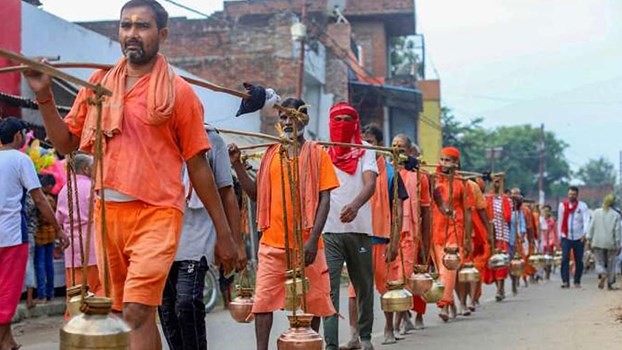Kanwar Yatra is named after the kānvar (कांवड़), a single pole (usually made of bamboo) with two roughly equal loads fastened or dangling from opposite ends. The kānvar is carried by balancing the middle of the pole on one or both shoulders. The Hindi word kānvar is derived from the Sanskrit kānvānrathi (काँवाँरथी). Kānvar-carrying pilgrims, called Kānvariās, carry covered water-pots in kānvars slung across their shoulders. This practice of carrying Kavad as a part of religious pilgrimage, especially by devotees of Lord Shiva, is widely followed throughout India (see Kavadi).
Kanwar yatra is related to the churning of the ocean of milk in the Hindu Puranas. When the poison came out before amrita and the world started burning from its heat, Shiva inhaled the poison. But, after inhaling it he started suffering from the negative energy of the poison. In Treta Yuga, Shiva’s devout follower Ravana brought holy water of Ganga by using kanwar and poured it on Shiva’s temple in Puramahadev. Thus releasing Shiva from the negative energy of the poison.
The Kānvar (or Kānwar/ Kāvaḍ) Yātrā is an annual pilgrimage of devotees of Shiva, known as Kānvarias (कावड़िया) or “Bhole” (भोले), to Hindu pilgrimage places of Haridwar, Gaumukh and Gangotri in Uttarakhand and Ajgaibinath, Sultanganj in Bhagalpur, Bihar to fetch holy waters of Ganges River. Millions of pilgrims fetch sacred water from river Ganga and carry on their shoulders for hundreds of miles to offer it in their local Śiva shrines, or specific temples such as Pura Mahadeva temple in Baghpat district and Augharnath temple in Meerut, Kashi Vishwanath temple in Varanasi.
Famous Route :-
Haridwar Route: This is the most popular route, where devotees travel from Haridwar to destinations such as the Neelkanth Mahadev Temple in Rishikesh or the Pura Mahadeva Temple in Baghpat, Uttar Pradesh.
Gaumukh Route: Beginning at Gaumukh, the source of the Ganga, devotees carry the sacred water to their chosen destinations.
Gangotri Route: Another significant route starts at Gangotri, with devotees transporting water to temples like Kashi Vishwanath in Varanasi or Baidyanath Dham in Deoghar, Jharkhand.
Given the large crowds during the Kanwar Yatra, it is essential for devotees to maintain personal hygiene and carry necessary medical supplies. Ensuring physical fitness is crucial, as the pilgrimage involves walking long distances. For safety, it is advisable to travel in groups, avoid isolated areas, and stay alert to prevent accidents.
The yatra poses logistical and security challenges due to the large number of participants. Authorities make special arrangements for medical aid, drinking water, and sanitation facilities. Traffic management is also a significant concern, especially in densely populated areas.

